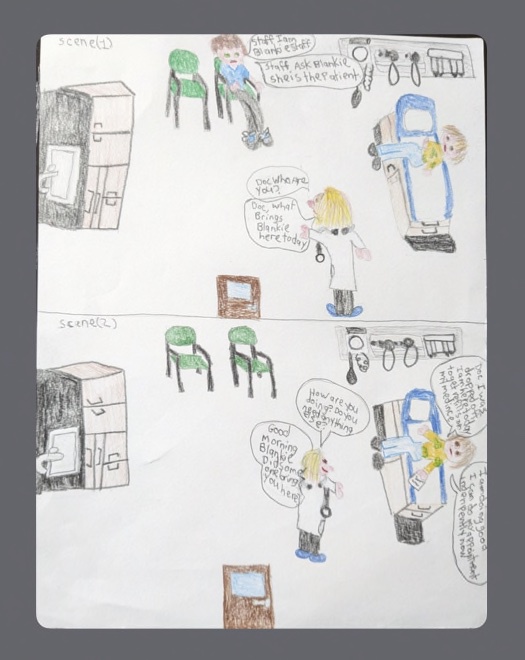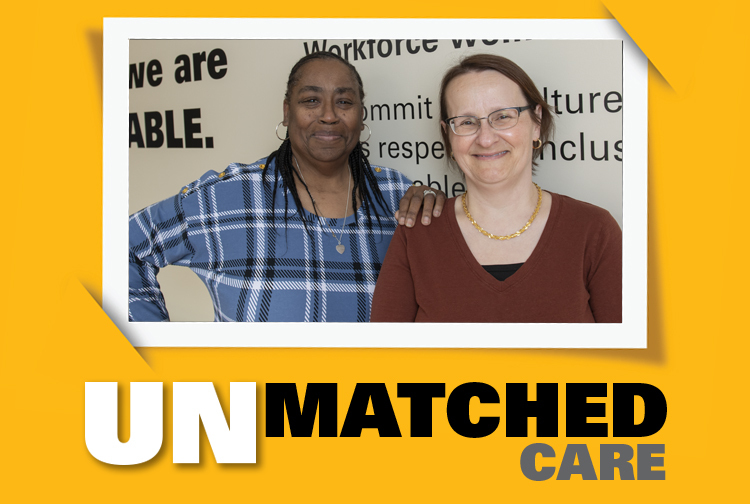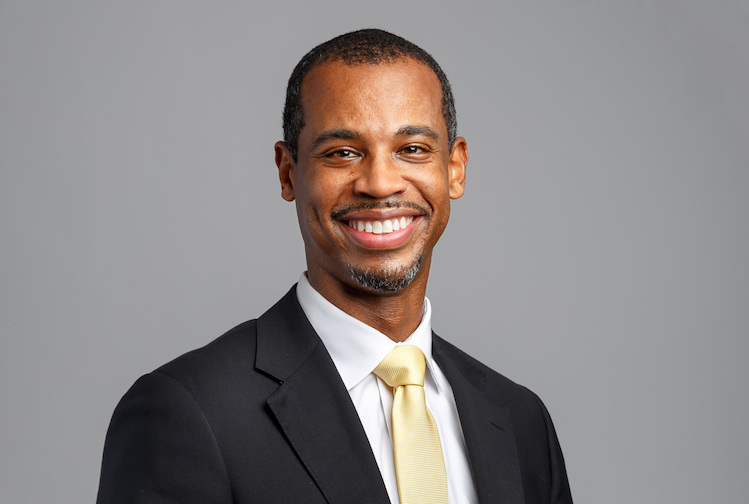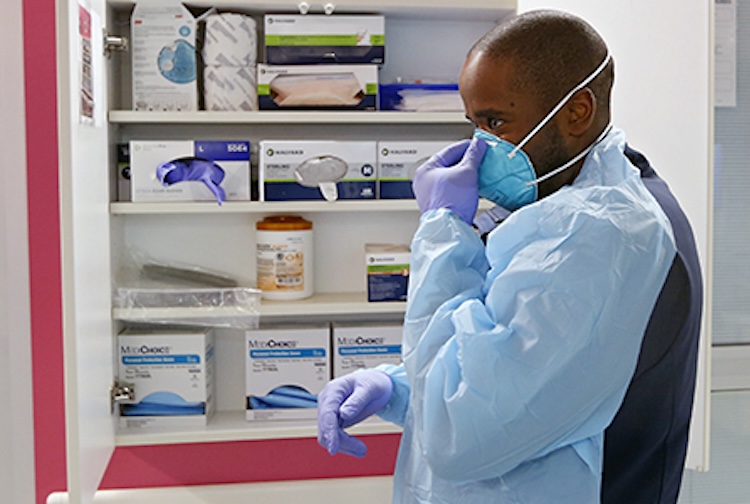
In art and sound, exhibit in VCU Medical Center gave voice to those with intellectual and developmental disabilities
Their experiences in health care – good and bad – were captured in a project by Healing Narratives, a program of the Partnership for People with Disabilities.
July 26, 2023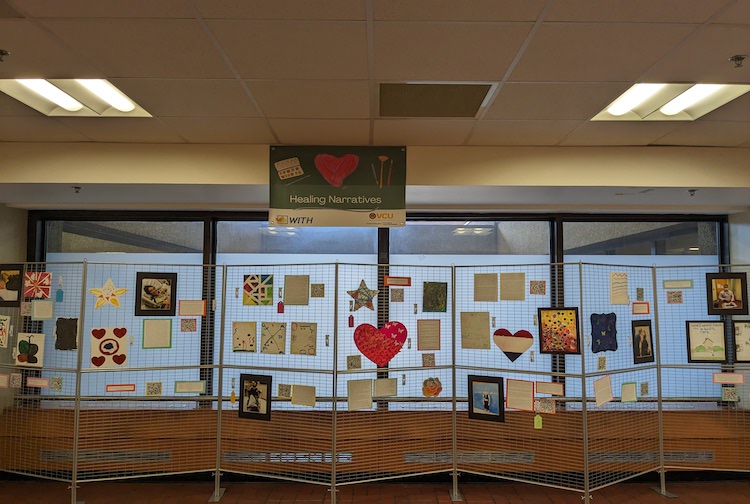 The Healing Narratives exhibit showcased artwork created by people with intellectual and developmental disabilities (IDD). It discusses how the artists want health care professionals to communicate and interact with them. (Contributed by Seb M. Prohn)
The Healing Narratives exhibit showcased artwork created by people with intellectual and developmental disabilities (IDD). It discusses how the artists want health care professionals to communicate and interact with them. (Contributed by Seb M. Prohn)
By Dina Weinstein
In one of the busiest hallways in the Main Hospital at VCU Medical Center, their voices could be heard – and seen. In July, as part of the Healing Narratives project, individuals with intellectual and developmental disabilities (IDD) used art and storytelling to prominently share their experiences from hospitals and doctor offices.
As part of Virginia Commonwealth University’s Partnership for People with Disabilities, Healing Narratives aims to promote the perspective of BIPOC adults – Black, Indigenous, People of Color – who identify as IDD. Seb Prohn, the partnership’s assistant director, says facilitators of the recent exhibit took an artistic approach for participants to describe their interactions with health professionals.
That included things that worked “and things that didn’t work for them – in order for them to guide, change and build awareness to health care professionals about what they want to see when they go to the doctor,” said Prohn, who is writing an academic paper analyzing the stories and issues highlighted in the project and through research.
Prohn and staff from VCU Health’s Arts in Healthcare initiative installed 25 art pieces on eight panels in the hospital corridor so doctors, nurses, patients and others could learn from the lived experiences of people with IDD. The Partnership collaborated with the Arc of Virginia, a self-advocacy group, and the Center for Independent Living in Richmond. The exhibit was funded by a grant from the WITH Foundation.
Rather than using traditional captions to accompany the artwork, organizers used a series of quotes without attribution, which maintained participant anonymity. QR codes linked viewers to audio files of quotes and stories making them more accessible for those with lower literacy or low vision. Elements of the project will be uploaded to the Partnership’s website.
“One of the goals is being able to amplify the voices of people who typically have their voices silenced or are not heard – or there is question as to how much their voices are sought after,” Prohn said.
One cartoon depicts how health professionals should directly engage people with disabilities in conversation and choices about their health and treatments. The accompanying quote read: “When it all comes down to it, the person that's the patient is the patient. So the doctor should use some form of communication to talk to the patient.”
Prohn noted that when participants had close and trusting relationships with their doctors, they felt a lot calmer, as did the doctors. Health outcomes also ended up being better, as patients might follow a doctor’s guidance better.
But when participants felt like doctors didn't talk to them, and instead engaged with a family member or a support person and didn't allow them to participate in decisions on their own health, that led to long-term distrust. It made them less likely to want to go to the doctor and raised their anxiety around medical intervention.
A Healing Narratives participant created a cartoon to describe how important it is for health care professionals to directly engage people with disabilities in conversation and choices about their health and treatments. The artist wrote: “When it all comes down to it, the person that's the patient is the patient. So the doctor should use some form of communication to talk to the patient.” (Contributed by Seb M. Prohn)
Angela West, a project facilitator and disability engagement specialist for Healing Narratives, says a highlight of the exhibit process was participants coming together to share their experiences.
“This was an opportunity just to be free and really express themselves. It was really fun to facilitate,” said West, who has a speech impairment as well as cerebral palsy and uses a wheelchair for mobility.
“If someone said something like, ‘I had trouble communicating with my doctor because I have a speech impediment,’ there could be someone in the group that would be like, “Yeah, I had that happen to me, too. And this is how I felt.’ It was really healing to come together and talk about ways to change the future,” West said.
Alexus Smith, who also identifies as having a developmental disability, helped co-facilitate training and data collection. Smith and West used medical consultation room photos to spur participants’ discussion of their treatment by health care workers, focusing on emotions. Facilitators also asked participants what could be improved about health care based on their experiences and what they thought was working well.
One participant response, about what makes a good doctor, said: “When I have questions or when I need to request something, he's always there to respond or to, like, support me and things like that. Yeah, he's good. He's a good doctor.”
Another set of quotes in the exhibit were responses to the prompt: What advice do you have for providers?
“Take time to listen to the person with disabilities who's coming to you with their discomforts and whatever they're feeling. Even if you have the assumption that maybe something is happening, don't assume – please take what people with disabilities have to say, because again, they know their body and they know when something is not right,” one quote read.
The exhibit also allowed for responses on tags that passers-by could attach with a hook. One person wrote: “This really catches my attention about how I need to be listening to people with disabilities and how important it is. “
Smith, a research consultant with the Partnership for People with Disabilities, says she liked the Healing Narratives process because it built community for the participants.
“I'm appreciative of the space that we were able to hold for people to share what was important to them,” she said. “It was really moving. And it was nice to be able to also resonate with the stories that were shared and be able to speak back to those and encourage conversation.”
For Smith, the exhibit is connected to her focus on how visual and cultural rhetoric are in conversation with one another. She is excited to see how putting the different types of stories and drawings together in conversation could spark other community conversations.
West added that she hopes the exhibit will inspire changes in medical practices to benefit the IDD population.
“If they're just a patient in the hospital, they can see that they're not alone,” West said. “Or maybe it can just be a window of joy and make their day a little bit brighter.”

